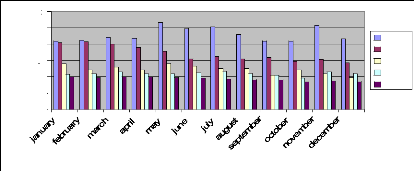II.2.11 LACK OF ACCESS TO PRODUCTIVE RESOURCES OR
INCOME
Women are among those with less access t land, while
accounting for a large share in small-scare food production. Land is a source
of food, shelter, social status and power. Land is also a source of employment
opportunities. Hence lack of access to this primary resource is largely
responsible for the poverty that haunts the poor, particularly the
women51. Laws and practices based on gender norms greatly limit
women's access to productive resources such as land, property, and credit.
These practices secure women's financial, material, and social dependence on
men. Research has shown that women who raise the issue of condom use with the
men on whom they are economically dependent risk violent conflict, loss of
support, or even abandonment. Dependent women are hesitant to leave risky
relationships as they fear terrible economic consequences52.
Because women do not have equal rights to property ownership,
widowhood usually means loss of the right of access to field where their labor
has been invested, and to their homes53. Lacking access to land
property and income, women are more likely to sell or exchange sex in unsafe
ways for money, goods and favors.
49 .UNAIDS.2005
50
www.eenet.org
51
www.allafrica.com
52
www.icaso.org
53
www.allafrica.org
Sex work offers not only a means of survival for some but a
route out of poverty for others54. Consequently, there is a need to
provide and enhance access to HIV prevention, treatment, care and support for
all sex workers, and to provide opportunities for sex workers who wish to
change their situation to move on within and/ or from sex work.
II.2.12 LACK OF EDUCATION AND TRAINING
Gender norms that limit women's access to educational and
vocational training, and the sexual division of labor that puts women in lower
status, jobs; Increase women's vulnerability to HIV infection. A close review
of the evidence on the links between poverty and the pressure to marry early
reveals that in wealthier countries, where girls have equitable access to
education, further training and other employment opportunities, early marriage
are rare55.The vast majority of women are employed in low paying,
seasonal, and insecure jobs in the informal and semi-formal sectors of the
labor market. An unequal standard in employment and channeling the majority of
women into low status occupations perpetuates and reinforces their inferior
status in economic relations.56International human rights
conventions provide for governments to address these discriminatory practices.
These circumstances also make it more likely that women will augment their
income by selling se, and without access to legal, social and HIV prevention
services, this limit their ability to negotiate safer sex.
54 Gender , Sexuality ,Rights And Hiv.2005.P18
55
www.eenet.org
56 Gender, Sexuality, Rights And Hiv.2005..P19

Parentage
12
10
4
8
6
2
0
Months
2003 2004 2005 2006 2007
Fig.1 Percentage of women infected with HIV/AIDS in
5years Source: trac
This pie charts help to understand how the woman is a most
group vulnerable to HIV infection due to different factors as we have discussed
them. Looking at the pie charts it indicates how the frequencies of
contamination was highly increased in 2003 and it begin to decrease in 2005 but
the percentage was still at high level ; 5% of women infected in 2005 is a high
number; these all social cultural factors discussed above have influenced in
increment of that number.
This pie chart shows us the number of women tested for HIV
infection during 5 years since 2003 to 2007, and how the frequencies of
infection were increasing. Many factors cause the women to be most vulnerable
group for HIV infection
CHAPTERIII: METHODOLOGY III.1. INTRODUCTION
This study used data collected from the women aged between
21-35 years to establish the social factors that influence the transmission of
HIV/AIDS. A number of techniques were utilised as indicated below.
| 


